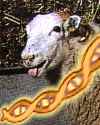
Born 18 Sep 1951; died 12 Aug 2004 at age 52.
Anthony John Clark was an English molecular biologist who was a pioneer in the application of molecular technology to farm animals. In 1985, he began work in genetic modification (at what is now the Roslin Institute) to produce a sheep giving milk with human proteins. He was successful within five years. Tracy* (born 1990) in each litre of her milk, produced 35g of alpha-1-antitrypsin (used in treatment of cystic fibrosis). During the 1990s, Clark continued to develop transgenic techniques on large animals. With his colleagues, he a produced a sheep from which a prion protein gene had been removed. Clark's work set the stage for Ian Wilmut's team at Roslin to clone a sheep, Dolly (1996), the result of transplanted the DNA of an adult sheep to an unfertilised egg cell. Clark died at age 52, suffering from depression, was found hanged in his holiday home.«[*Ref: see Biotechnology (9 Sep 1991), 9, 830-835. Image: Tracy the sheep with DNA graphic.]
Anthony John Clark was an English molecular biologist who was a pioneer in the application of molecular technology to farm animals. In 1985, he began work in genetic modification (at what is now the Roslin Institute) to produce a sheep giving milk with human proteins. He was successful within five years. Tracy* (born 1990) in each litre of her milk, produced 35g of alpha-1-antitrypsin (used in treatment of cystic fibrosis). During the 1990s, Clark continued to develop transgenic techniques on large animals. With his colleagues, he a produced a sheep from which a prion protein gene had been removed. Clark's work set the stage for Ian Wilmut's team at Roslin to clone a sheep, Dolly (1996), the result of transplanted the DNA of an adult sheep to an unfertilised egg cell. Clark died at age 52, suffering from depression, was found hanged in his holiday home.«[*Ref: see Biotechnology (9 Sep 1991), 9, 830-835. Image: Tracy the sheep with DNA graphic.]
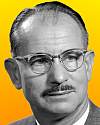
1958
Born 18 Sep 1907; died 7 Sep 1991 at age 83.
Edwin Mattison McMillan was an American nuclear physicist who shared the Nobel Prize for Chemistry in 1951 (with Glenn T. Seaborg) for his discovery of element 93. Just as the planet Neptune is beyond Uranus, this new element was named neptunium, the first element beyond uranium, thus called a transuranium element. By irradiating uranium with rapid neutrons or with heavy-hydrogen nuclei (deuterons), other neptunium isotopes were soon produced in Berkeley. By 1940, McMillan with his colleagues working with Seaborg found that the radioactive decay of neptunium disintegrates yields element 94, called plutonium, after the planet Pluto beyond Neptune. During WW II he was engaged in national defence nuclear research.«
Edwin Mattison McMillan was an American nuclear physicist who shared the Nobel Prize for Chemistry in 1951 (with Glenn T. Seaborg) for his discovery of element 93. Just as the planet Neptune is beyond Uranus, this new element was named neptunium, the first element beyond uranium, thus called a transuranium element. By irradiating uranium with rapid neutrons or with heavy-hydrogen nuclei (deuterons), other neptunium isotopes were soon produced in Berkeley. By 1940, McMillan with his colleagues working with Seaborg found that the radioactive decay of neptunium disintegrates yields element 94, called plutonium, after the planet Pluto beyond Neptune. During WW II he was engaged in national defence nuclear research.«
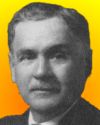
Born 18 Sep 1870; died 25 Aug 1947 at age 76.
American anthropologist who devised the age-area concept which held that the age of cultural traits could be found by correlating the diffusion of those traits throughout their associated area. (It is not presently regarded as practical.) He contributed much research on Native Americans, beginning (1902-05) with the Blackfoot, and various Siouan tribes of Montana and the Dakotas. He wrote many articles, and six books. Wissler's theories on culture diverged from those of his contemporaries, such as Franz Boas. Wissler believed that culture was biologically innate in humans. He held the position of Curator of Ethnology, and with the American Museum of Natural History for 40 years.«
American anthropologist who devised the age-area concept which held that the age of cultural traits could be found by correlating the diffusion of those traits throughout their associated area. (It is not presently regarded as practical.) He contributed much research on Native Americans, beginning (1902-05) with the Blackfoot, and various Siouan tribes of Montana and the Dakotas. He wrote many articles, and six books. Wissler's theories on culture diverged from those of his contemporaries, such as Franz Boas. Wissler believed that culture was biologically innate in humans. He held the position of Curator of Ethnology, and with the American Museum of Natural History for 40 years.«
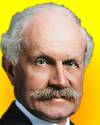
Born 18 Sep 1869; died 21 Apr 1957 at age 87.
Sir John Graham Kerr was an English embryologist whose research added knowledge of the evolution of vertebrates. He also promoted ideas in naval camouflage for WWI. Early in his career, pursuing his zoological interests, Kerr went on two expeditions to the Pilcomayo River in South America, collecting samples for his subsequent research. He referenced his observation of animal camouflage in South America in a letter to Winston Churchill, (24 Sep 1914), and recommended painting war ships with graduated shading. He also communicated with Ernest Bevin and Clement Atlee on his camouflage ideas. He deserves credit his pioneering efforts, although often overshadowed by later “dazzle” scheme of camouflage.« more
Sir John Graham Kerr was an English embryologist whose research added knowledge of the evolution of vertebrates. He also promoted ideas in naval camouflage for WWI. Early in his career, pursuing his zoological interests, Kerr went on two expeditions to the Pilcomayo River in South America, collecting samples for his subsequent research. He referenced his observation of animal camouflage in South America in a letter to Winston Churchill, (24 Sep 1914), and recommended painting war ships with graduated shading. He also communicated with Ernest Bevin and Clement Atlee on his camouflage ideas. He deserves credit his pioneering efforts, although often overshadowed by later “dazzle” scheme of camouflage.« more
Zoology for Medical Students (reprint), by J. Graham Kerr. - book suggestion.
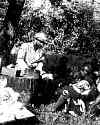
1930
Born 18 Sep 1869; died 19 Jan 1954 at age 84.
German anthropologist and sociologist whose comparative studies of social institutions, were made based on research expeditions included the Solomon Islands and Micronesia (1906-09, 1932), New Guinea (1912-15), and East Africa (1930). During the first Melanesian expedition (1906-09), he concentrated on South Bougainville (the Buins) and the Bismark Archipelago (Baining and New Ireland). His main objective was collecting objects of museum interest, and making sound and visual recordings. However, he also observed what he regarded as the negative effects of colonization. The plantation policy there was distributing lands to settlers, but Thurwald was particularly concerned that the settlers engaged labour on a more or less forced basis.«[Image: Thurnwald making field recordings in 1930.]
German anthropologist and sociologist whose comparative studies of social institutions, were made based on research expeditions included the Solomon Islands and Micronesia (1906-09, 1932), New Guinea (1912-15), and East Africa (1930). During the first Melanesian expedition (1906-09), he concentrated on South Bougainville (the Buins) and the Bismark Archipelago (Baining and New Ireland). His main objective was collecting objects of museum interest, and making sound and visual recordings. However, he also observed what he regarded as the negative effects of colonization. The plantation policy there was distributing lands to settlers, but Thurwald was particularly concerned that the settlers engaged labour on a more or less forced basis.«[Image: Thurnwald making field recordings in 1930.]
Economics in Primitive Communities, by Richard Thurnwald. - book suggestion.
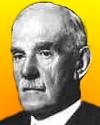
Born 18 Sep 1854; died 15 Dec 1935 at age 81.
English physicist who was the first director of the UK National Physical Laboratory, from 1 Jan 1900 until his retirement in Sep 1919. At first, the laboratory's income depended on much routine, commercial testing, but Glazebrook championed fundamental, industrially oriented research. With support from individual donors, buildings were added for electrical work, metrology, and engineering. Data useful to the shipbuilding industry was collected in pioneering experimental work on models of ships made possible by a tank funded by Alfred Yarrow (1908). From 1909, laboratory began work benefitting the embryonic aeronautics industry, at the request of the secretary of state for war. The lab to contributed substantially to military needs during WW I.«
English physicist who was the first director of the UK National Physical Laboratory, from 1 Jan 1900 until his retirement in Sep 1919. At first, the laboratory's income depended on much routine, commercial testing, but Glazebrook championed fundamental, industrially oriented research. With support from individual donors, buildings were added for electrical work, metrology, and engineering. Data useful to the shipbuilding industry was collected in pioneering experimental work on models of ships made possible by a tank funded by Alfred Yarrow (1908). From 1909, laboratory began work benefitting the embryonic aeronautics industry, at the request of the secretary of state for war. The lab to contributed substantially to military needs during WW I.«
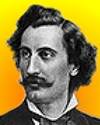
Born 18 Sep 1843; died 14 Sep 1895 at age 51.
British-born American entomologist who pioneered the scientific study of insects for their economic impact in agriculture. He was a keen observer of relationships in nature, and enhanced his written observations with drawings. He initiated biological control. After studying the parasites and predators of the cottony cushion scale, which was destroying the citrus industry in California, he introduced (1888) a natural enemy of the scale from Australia. The effectiveness of the Vedalia cardinalis beetle in reducing the populations of the cottony cushion scale promoted the study of biological control of pests. He helped establish the Division of Entomology of the U.S. Department of Agriculture.«
British-born American entomologist who pioneered the scientific study of insects for their economic impact in agriculture. He was a keen observer of relationships in nature, and enhanced his written observations with drawings. He initiated biological control. After studying the parasites and predators of the cottony cushion scale, which was destroying the citrus industry in California, he introduced (1888) a natural enemy of the scale from Australia. The effectiveness of the Vedalia cardinalis beetle in reducing the populations of the cottony cushion scale promoted the study of biological control of pests. He helped establish the Division of Entomology of the U.S. Department of Agriculture.«
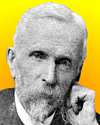
Born 18 Sep 1839; died 14 Nov 1919 at age 80.
Scottish physicist and meteorologist who is known for his studies on atmospheric dust, the formation of dew, cyclones and evaporation. He invented the koniscope to detect and study atmospheric dust particles. He determined that condensation of atmospheric water vapor from clouds and fogs begins on the surface of microscopic particles (now known as Aitken nuclei) as a crucial step in the formation of rain and dew. Combustion produces a profusion of such particles. Suffering from ill health, he worked from a laboratory in his Falkirk home. Much of his work was published in the journals of the Royal Society of Edinburgh.«
Scottish physicist and meteorologist who is known for his studies on atmospheric dust, the formation of dew, cyclones and evaporation. He invented the koniscope to detect and study atmospheric dust particles. He determined that condensation of atmospheric water vapor from clouds and fogs begins on the surface of microscopic particles (now known as Aitken nuclei) as a crucial step in the formation of rain and dew. Combustion produces a profusion of such particles. Suffering from ill health, he worked from a laboratory in his Falkirk home. Much of his work was published in the journals of the Royal Society of Edinburgh.«
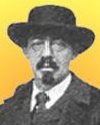
Born 18 Sep 1831; died 30 Jun 1898 at age 66.
German-Austrian inventor who built four of the world's earliest gasoline-powered automobiles. Marcus held about 76 patents (though none on his automobiles) in about a dozen countries, including an electric lamp (1877), various other electrical devices, a carburetor and an igniter for explosives. He installed the first electric bell in the bedroom of Empress Elisabeth, and he became an instructor in physics to the ill-fated Crown Prince Rudolf. He built and marketed internal combustion engines. Marcus first started working on a self-propelled vehicle about 1860, making significant contributions in the course of further development. Photographs of his first car, built about 1864, were taken in 1870. The second car - the landmark - was built about 1875 in his Vienna factory. It was first equipped with a two-cycle engine, and later, a four-cycle engine.
German-Austrian inventor who built four of the world's earliest gasoline-powered automobiles. Marcus held about 76 patents (though none on his automobiles) in about a dozen countries, including an electric lamp (1877), various other electrical devices, a carburetor and an igniter for explosives. He installed the first electric bell in the bedroom of Empress Elisabeth, and he became an instructor in physics to the ill-fated Crown Prince Rudolf. He built and marketed internal combustion engines. Marcus first started working on a self-propelled vehicle about 1860, making significant contributions in the course of further development. Photographs of his first car, built about 1864, were taken in 1870. The second car - the landmark - was built about 1875 in his Vienna factory. It was first equipped with a two-cycle engine, and later, a four-cycle engine.
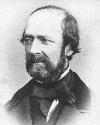
Born 18 Sep 1819; died 11 Feb 1868 at age 48. quotes
French physicist whose Foucault Pendulum experimentally proved that the Earth rotates on its axis (6 Jan 1851). Using a long pendulum with a heavy bob, he showed its plane rotated at a rate related to Earth's angular velocity and the latitude of the site. He studied medicine and physics and became an assistant at the Paris Observatory (1855). He invented an accurate test of a lens for chromatic and spherical aberrations. Working with Armand Fizeau, and also independently, he made accurate measurements of the absolute velocity of light. In 1850, Foucault showed that light travels slower in water than in air. He also built a gyroscope (1852), the Foucault's prism (1857) and made improvements for mirrors of reflecting telescopes.« more
French physicist whose Foucault Pendulum experimentally proved that the Earth rotates on its axis (6 Jan 1851). Using a long pendulum with a heavy bob, he showed its plane rotated at a rate related to Earth's angular velocity and the latitude of the site. He studied medicine and physics and became an assistant at the Paris Observatory (1855). He invented an accurate test of a lens for chromatic and spherical aberrations. Working with Armand Fizeau, and also independently, he made accurate measurements of the absolute velocity of light. In 1850, Foucault showed that light travels slower in water than in air. He also built a gyroscope (1852), the Foucault's prism (1857) and made improvements for mirrors of reflecting telescopes.« more
Pendulum: Leon Foucault and the Triumph of Science, by Amir D. Aczel. - book suggestion.
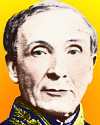
1869
Born 18 Sep 1804; died 29 Jan 1883 at age 78. quotes
Charles Emmanuel Sédillot was a French surgeon who coined the word microbe for a microorganism in 1871, which Émile Littré included in the 1886 edition of his Dictionary of Medicine. Sédillot started his career as a military doctor (1825) and served in the Polish campaign as a surgeon's aide. By 1841, he became a professor of clinical surgery at Strasbourg military hospital. Sédillot was a pioneer in aseptic surgery, and promoted the use of chloroform anesthesia. Among other surgical techniques he developed, he was the first to apply a stomach fistula, and coined the term gastrostomy for that operation. He was the author of numerous publications, including the first book in France on anesthesia (Jan 1848). Later in life he suffered progressive deafness, and no longer able to participate in learned societies, he retired.«
Charles Emmanuel Sédillot was a French surgeon who coined the word microbe for a microorganism in 1871, which Émile Littré included in the 1886 edition of his Dictionary of Medicine. Sédillot started his career as a military doctor (1825) and served in the Polish campaign as a surgeon's aide. By 1841, he became a professor of clinical surgery at Strasbourg military hospital. Sédillot was a pioneer in aseptic surgery, and promoted the use of chloroform anesthesia. Among other surgical techniques he developed, he was the first to apply a stomach fistula, and coined the term gastrostomy for that operation. He was the author of numerous publications, including the first book in France on anesthesia (Jan 1848). Later in life he suffered progressive deafness, and no longer able to participate in learned societies, he retired.«
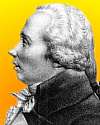
Born 18 Sep 1752; died 9 Jan 1833 at age 80. quotes
French mathematician who contributed to number theory, celestial mechanics and elliptic functions. In 1794, he was put in charge of the French government's department that was standardizing French weights and measures. In 1813, he took over as head of the Bureau des Longitudes upon the death of Lagrange, its former chief. It was in a paper on celestial mechanics concerning the motion of planets (1784) that he first introduced the Legendre Polynomials. His provided outstanding work on elliptic functions (1786), and his classic treatise on the theory of numbers (1798) and also worked on the method of least squares.«[DSB gives date of death 9 Jan 1833. EB gives 10 Jan 1833.]
French mathematician who contributed to number theory, celestial mechanics and elliptic functions. In 1794, he was put in charge of the French government's department that was standardizing French weights and measures. In 1813, he took over as head of the Bureau des Longitudes upon the death of Lagrange, its former chief. It was in a paper on celestial mechanics concerning the motion of planets (1784) that he first introduced the Legendre Polynomials. His provided outstanding work on elliptic functions (1786), and his classic treatise on the theory of numbers (1798) and also worked on the method of least squares.«[DSB gives date of death 9 Jan 1833. EB gives 10 Jan 1833.]
Died 18 Sep 1994 at age 73 (born 8 Jan 1921).
American physician who contributed to the acceptance of the lifesaving CPR technique. In 1949-50, he evaluated the various methods of artificial ventilation with arm maneuvers and chest compressions used at the time, and found them to be of marginal benefit. Dr. James Elam published the first scientific paper (1956) showing that oxygen could be delivered into a non-breathing patient's lungs from a rescuer's exhaled breath, using a tube. Dr. Peter Safar followed with a simple gadget-free method, exhaling air directly into the mouth of a non-breathing person (1957). At the University of Southern California, quickly repeated the experiments in children. Within a year, these three doctors convinced the world to change artificial breathing methods.«
American physician who contributed to the acceptance of the lifesaving CPR technique. In 1949-50, he evaluated the various methods of artificial ventilation with arm maneuvers and chest compressions used at the time, and found them to be of marginal benefit. Dr. James Elam published the first scientific paper (1956) showing that oxygen could be delivered into a non-breathing patient's lungs from a rescuer's exhaled breath, using a tube. Dr. Peter Safar followed with a simple gadget-free method, exhaling air directly into the mouth of a non-breathing person (1957). At the University of Southern California, quickly repeated the experiments in children. Within a year, these three doctors convinced the world to change artificial breathing methods.«
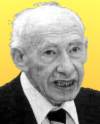
Died 18 Sep 1977 at age 88 (born 17 Oct 1888).
Paul Isaak Bernays was a Swiss mathematician and logician who is known for his attempts to develop a unified theory of mathematics. Bernays, influenced by Hilbert's thinking, believed that the whole structure of mathematics could be unified as a single coherent entity. In order to start this process it was necessary to devise a set of axioms on which such a complete theory could be based. He therefore attempted to put set theory on an axiomatic basis to avoid the paradoxes. Between 1937 and 1954 Bernays wrote a whole series of articles in the Journal of Symbolic Logic which attempted to achieve this goal. In 1958 Bernays published Axiomatic Set Theory in which he combined together his work on the axiomatisation of set theory.
Paul Isaak Bernays was a Swiss mathematician and logician who is known for his attempts to develop a unified theory of mathematics. Bernays, influenced by Hilbert's thinking, believed that the whole structure of mathematics could be unified as a single coherent entity. In order to start this process it was necessary to devise a set of axioms on which such a complete theory could be based. He therefore attempted to put set theory on an axiomatic basis to avoid the paradoxes. Between 1937 and 1954 Bernays wrote a whole series of articles in the Journal of Symbolic Logic which attempted to achieve this goal. In 1958 Bernays published Axiomatic Set Theory in which he combined together his work on the axiomatisation of set theory.
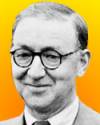
Died 18 Sep 1967 at age 70 (born 27 May 1897).
Sir John Douglas Cockcroft was a British physicist, who shared (with Ernest T.S. Walton of Ireland) the 1951 Nobel Prize for Physics for pioneering the use of particle accelerators to study the atomic nucleus. Together, in 1929, they built an accelerator, the Cockcroft-Walton generator, that generated large numbers of particles at lower energies - the first atom-smasher. On 14 Apr 1932, they used it to disintegrate lithium atoms by bombarding them with protons, the first artificial nuclear reaction not utilizing radioactive substances. They were first to split the atom. They conducted further research on the splitting of other atoms and established the importance of accelerators as a tool for nuclear research. Their accelerator design became one of the most useful in the world's laboratories.«
Sir John Douglas Cockcroft was a British physicist, who shared (with Ernest T.S. Walton of Ireland) the 1951 Nobel Prize for Physics for pioneering the use of particle accelerators to study the atomic nucleus. Together, in 1929, they built an accelerator, the Cockcroft-Walton generator, that generated large numbers of particles at lower energies - the first atom-smasher. On 14 Apr 1932, they used it to disintegrate lithium atoms by bombarding them with protons, the first artificial nuclear reaction not utilizing radioactive substances. They were first to split the atom. They conducted further research on the splitting of other atoms and established the importance of accelerators as a tool for nuclear research. Their accelerator design became one of the most useful in the world's laboratories.«
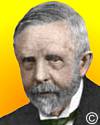
Died 18 Sep 1939 at age 82 (born 16 Sep 1857). quotes
English electrical engineer and inventor who co-founded the firm of Evershed and Vignoles, Ltd., makers of electrical instruments (reg. 5 Feb 1895). His electrical business career began with the Hammond company, a pioneer manufacturer of electric incandescent lamps, until it failed. In 1885, he became the manager of the small Goolden and Trotter factory, formed to manufacture the Cardew voltmeter. He acquired the successor business in 1895 with his assistant Ernest B. Vignoles. Their products became internationally known with the trademark “Megger.” They also investigated the magnetic phenomena in the cores of transformers, permanent magnets, and the physical structure of non-conductors. He devised a helm indicator and important gun controls for the Navy used in WW I. The company was taken over by AVO International in 1986.«[Date of death from obituary which says it was a "couple of days after passing his 82nd birthday" implying the date of birth above. Seen elsewhere as 1858.] more
English electrical engineer and inventor who co-founded the firm of Evershed and Vignoles, Ltd., makers of electrical instruments (reg. 5 Feb 1895). His electrical business career began with the Hammond company, a pioneer manufacturer of electric incandescent lamps, until it failed. In 1885, he became the manager of the small Goolden and Trotter factory, formed to manufacture the Cardew voltmeter. He acquired the successor business in 1895 with his assistant Ernest B. Vignoles. Their products became internationally known with the trademark “Megger.” They also investigated the magnetic phenomena in the cores of transformers, permanent magnets, and the physical structure of non-conductors. He devised a helm indicator and important gun controls for the Navy used in WW I. The company was taken over by AVO International in 1986.«[Date of death from obituary which says it was a "couple of days after passing his 82nd birthday" implying the date of birth above. Seen elsewhere as 1858.] more
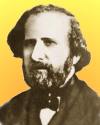
Died 18 Sep 1896 at age 76 (born 23 Sep 1819). quotes
French physicist who was the first to measure the speed of light successfully without using astronomical calculations (1849). Fizeau sent a narrow beam of light between gear teeth on the edge of a rotating wheel. The beam then traveled to a mirror 8 km/5 mi away and returned to the wheel where, if the spin were fast enough, a tooth would block the light. Knowing this time from the rotational speed of the wheel, and the mirror's distance, Fizeau directly measured the speed of light. He also found that light travels faster in air than in water, which confirmed the wave theory of light, and that the motion of a star affects the position of the lines in its spectrum. With Jean Foucault, he proved the wave nature of the Sun's heat rays by showing their interference (1847).
French physicist who was the first to measure the speed of light successfully without using astronomical calculations (1849). Fizeau sent a narrow beam of light between gear teeth on the edge of a rotating wheel. The beam then traveled to a mirror 8 km/5 mi away and returned to the wheel where, if the spin were fast enough, a tooth would block the light. Knowing this time from the rotational speed of the wheel, and the mirror's distance, Fizeau directly measured the speed of light. He also found that light travels faster in air than in water, which confirmed the wave theory of light, and that the motion of a star affects the position of the lines in its spectrum. With Jean Foucault, he proved the wave nature of the Sun's heat rays by showing their interference (1847).
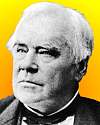
c.1887
Died 18 Sep 1892 at age 77 (born 18 May 1815).
British-American engineer who originated scientific methods to test hydraulic machinery and invented the Francis mixed-flow reaction turbine (combining radial- and axial-flow) for low-pressure installations. He emigrated to the U.S. at age 18, and joined the Locks and Canal Co., Lowell, Mass. In 1837, he became its Chief Engineer until retirement. The company owned and operated Lowell's canal system providing waterpower for the textile industry there. Francis designed a more efficient successor to the Boyden turbine, with Uriah A. Boyden of Boston. Being half the size but equal in power, two fit in each wheel pit and doubled power generation.The turbine acted as a hydraulic motor to drive many mill machines through belts and line shafts. He was a founding member of the American Society of Civil Engineers and its president in 1880.« more
British-American engineer who originated scientific methods to test hydraulic machinery and invented the Francis mixed-flow reaction turbine (combining radial- and axial-flow) for low-pressure installations. He emigrated to the U.S. at age 18, and joined the Locks and Canal Co., Lowell, Mass. In 1837, he became its Chief Engineer until retirement. The company owned and operated Lowell's canal system providing waterpower for the textile industry there. Francis designed a more efficient successor to the Boyden turbine, with Uriah A. Boyden of Boston. Being half the size but equal in power, two fit in each wheel pit and doubled power generation.The turbine acted as a hydraulic motor to drive many mill machines through belts and line shafts. He was a founding member of the American Society of Civil Engineers and its president in 1880.« more
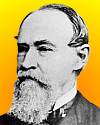
Died 18 Sep 1891 at age 74 (born 29 Jan 1817).
American meteorologist who was an important contributor to the understanding of oceanic and atmospheric circulation. He was able to show the interrelation of the various forces upon the Earth's surface, such as gravity, rotation and friction. Ferrel was first to mathematically demonstrate the influence of the Earth's rotation on the presence of high and low pressure belts encircling the Earth, and on the deflection of air and water currents. The latter was a derivative of the effect theorized by Gustave de Coriolis in 1835, and became known as Ferrel's law. Ferrel also considered the effect that the gravitational pull of the Sun and Moon might have on the Earth's rotation and concluded (without proof, but correctly) that the Earth's axis wobbles a bit. more
American meteorologist who was an important contributor to the understanding of oceanic and atmospheric circulation. He was able to show the interrelation of the various forces upon the Earth's surface, such as gravity, rotation and friction. Ferrel was first to mathematically demonstrate the influence of the Earth's rotation on the presence of high and low pressure belts encircling the Earth, and on the deflection of air and water currents. The latter was a derivative of the effect theorized by Gustave de Coriolis in 1835, and became known as Ferrel's law. Ferrel also considered the effect that the gravitational pull of the Sun and Moon might have on the Earth's rotation and concluded (without proof, but correctly) that the Earth's axis wobbles a bit. more
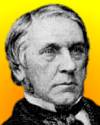
Died 18 Sep 1860 at age 55 (born 9 Aug 1805).
English civil engineer who build many significant early main-line railways. In 1823, he began learning his trade while surveying railways and working with Robert Stephenson at his locomotive factory. Within three years, Locke became a railway construction engineer under George Stephenson, and by 1835 was a Chief Engineer building the Grand Junction Railway. Locke put double-headed rails into use that were secured in chairs on wooden sleepers. These developed into the standard bullhead track used for a century afterwards for railways throughout Britain. In addition to a number of main lines in England, he undertook engineering for several early main lines in France. In 1847, he won election to serve as Member of Parliament for Honiton.«
English civil engineer who build many significant early main-line railways. In 1823, he began learning his trade while surveying railways and working with Robert Stephenson at his locomotive factory. Within three years, Locke became a railway construction engineer under George Stephenson, and by 1835 was a Chief Engineer building the Grand Junction Railway. Locke put double-headed rails into use that were secured in chairs on wooden sleepers. These developed into the standard bullhead track used for a century afterwards for railways throughout Britain. In addition to a number of main lines in England, he undertook engineering for several early main lines in France. In 1847, he won election to serve as Member of Parliament for Honiton.«
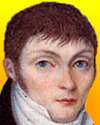
Died 18 Sep 1840 at age 56 (born 22 Oct 1783).
Constantine Samuel Rafinesque was a French naturalist, traveller and writer who, in spite of work of variable reliability, still substantially expanded knowledge with extensive travels, collecting, cataloging and naming huge numbers of plants and some animals. Among these are many new species he is credited with being the first to describe. Years ahead of Charles Darwin's theory of evolution, Rafinesque conceived his own ideas. He thought that species had, even within the timeframe of a century, a continuing tendency for varieties to appear that would diverge in their characteristics to the point of forming new species. Accordingly, he was over-enthusiastic at distinguishing what he called new species. He wrote prolifically, and often self-published. His work varied from brilliant insightfulness to carelessness. He had a difficult personality, was in his time often dismissed and died impoverished.«[He was born in Turkey, but his nationality came from his father.] more
Constantine Samuel Rafinesque was a French naturalist, traveller and writer who, in spite of work of variable reliability, still substantially expanded knowledge with extensive travels, collecting, cataloging and naming huge numbers of plants and some animals. Among these are many new species he is credited with being the first to describe. Years ahead of Charles Darwin's theory of evolution, Rafinesque conceived his own ideas. He thought that species had, even within the timeframe of a century, a continuing tendency for varieties to appear that would diverge in their characteristics to the point of forming new species. Accordingly, he was over-enthusiastic at distinguishing what he called new species. He wrote prolifically, and often self-published. His work varied from brilliant insightfulness to carelessness. He had a difficult personality, was in his time often dismissed and died impoverished.«[He was born in Turkey, but his nationality came from his father.] more
Constantine Samuel Rafinesque: A Voice in the American Wilderness, by Leonard Warren. - book suggestion.
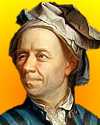
Died 18 Sep 1783 at age 76 (born 15 Apr 1707). quotes
Leonhard Paul Euler was a Swiss mathematician and physicist, one of the founders of pure mathematics. He not only made decisive and formative contributions to the subjects of geometry, calculus, mechanics, and number theory but also developed methods for solving problems in observational astronomy and demonstrated useful applications of mathematics in technology. At age 28, he blinded one eye by staring at the sun while working to invent a new way of measuring time.
Leonhard Paul Euler was a Swiss mathematician and physicist, one of the founders of pure mathematics. He not only made decisive and formative contributions to the subjects of geometry, calculus, mechanics, and number theory but also developed methods for solving problems in observational astronomy and demonstrated useful applications of mathematics in technology. At age 28, he blinded one eye by staring at the sun while working to invent a new way of measuring time.
Euler: The Master of Us All, by William Dunham. - book suggestion.
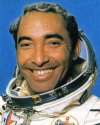
In 1980, Cuban cosmonaut Arnaldo Tamayo-Mendéz became the first person of color and the first Latin American sent into space on board Soyuz 38 (for 188.7 hours), one of a two men comprising the seventh international crew under the Intercosmos programme. Tamayo-Mendéz spent several days aboard the Soviet space laboratory Salyut 6. He engaged in several experiments and measured the speed at which sugar crystals grow in space. He was born 29 Jan 1942.
In 1927, Columbia Phonograph Broadcasting System went on the air with 47 radio stations. However, the radio network lost money in its first year, and on 18 Jan 1929 Columbia Records sold out to a group of private investors for $400,000, headed by William S. Paley, a Philadelphia cigar manufacturer. The radio network was renamed The Columbia Broadcasting System (CBS).
In 1895, Daniel David Palmer gave the first chiropractic adjustment to Harvey Lillard in Davenport, Iowa - now the home of Palmer Chiropractic College.
In 1830, B&O locomotive Tom Thumb, the first locomotive built in America, lost in a 14-km race with a horse due to a boiler leak.




